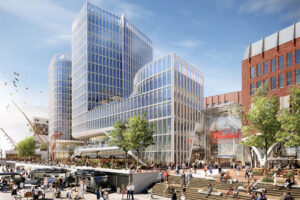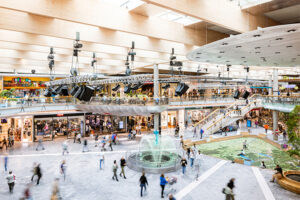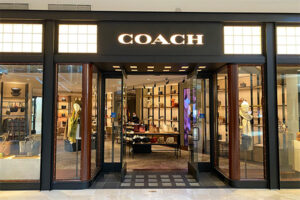ACROSS: Until a decade ago, retail parks had more of a shadowy existence within the retail real estate industry. The primary focus was on shopping centers. The situation has radically changed. Why?
ROMAN MÜLLER: The increasing popularity of retail parks and local supply centers can be explained from a number of vantage points. Successful retail properties have to be more attractive to consumers, tenants, and investors alike than other types of real estate. From the consumer’s point of view, retail parks offer a high degree of convenience, such as excellent parking facilities and ground level access to shops. Everything that one needs for quick, routine shopping can be found within a small area. From the tenant’s perspective, the ratio between rental costs and retail turnover is particularly positive. That can be attributed to the efficient building structures. Unlike shopping centers, for example, no costs associated with mall areas have to be borne by the tenants.
HENRIKE WALDBURG: With regard to convenience: Generally speaking, such locations are easily accessible for private transport. From the customer’s standpoint, it always comes down to purchasing on demand. That should be as convenient as possible and must be capable of being quickly carried out.
ACROSS: Retail parks have since established themselves as an independent asset class. From the investor’s perspective, what makes them so interesting?
MÜLLER: Most of the anchor tenants come from the growing food and drugstore sectors. In addition, from the investor’s point of view, the mix of tenants made up of creditworthy chain stores and the generally long-term contract periods are highly attractive.
WALDBURG: The high online resilience of the tenant base is another factor. Due to the fact that concepts are still inadequate, in terms of delivery, freshness, etc., online penetration rates for food and drugstore goods will remain very low for the foreseeable future. Nevertheless, operators continue to fine-tune their online presence and Click & Collect systems. Therefore, digitalization is also of relevance to the food trade.
MÜLLER: That is a very important point. Online sales in the food and drugstore sectors currently account for a mere 1 to 2 percent of total sales, with only moderate growth forecasts.
WALDBURG: However, it should not be forgotten that retail parks that feature hypermarkets with a high non-food share are not immune to online competition. The trend tends to be spotted in smaller, full-range stores or in combination with specialists, such as discounters. From the owner’s perspective, the question regarding what should be done with the remaining space arises. Construction law is often so restrictive that it leaves hardly any flexibility when it comes to usage. When investing, that is always the focus of detailed analysis.
ACROSS: Why is it so essential to have retail parks in your portfolio?
WALDBURG: It is an asset class that belongs in any well-balanced portfolio. Our funds are known to invest in commercial real estate, and, in a mixed-use portfolio, there is always an allocation for retail – in addition to other types of use, such as offices, logistics facilities, or hotels.
ACROSS: How many retail parks does Union Investment have in its portfolio?
MÜLLER: There are currently 13 retail parks– excluding service mandates – in our actively managed funds. That amounts to almost precisely half a billion euros of property volume. We are also in the process of concluding three additional acquisitions in the DACH region.
WALDBURG: The retail allocation of our funds currently stands at approximately 30 percent. Given the fact that retail real estate continues to be an investment focus, retail parks and local shopping centers will continue to significantly contribute to the scaling of our existing funds in the future. However, like any other market participant, we are, of course, subject to market conditions. As a result, we have to find the right properties in order to fully exploit the outstanding performance on the capital side of the cooperative financial group. That is a central issue for us.
ACROSS: What markets are of interest to you?
WALDBURG: Our investments are primarily made in Germany and Austria. However, we keep an eye on the whole of Europe. First and foremost, we regard Sweden and the Netherlands as suitable growth markets for retail parks.
ACROSS: What catchment area has to be available in order for an acquisition to make sense?
MÜLLER: The correlation between population density and the competitive situation in the core catchment area is a key factor. According to various statistics, daily consumption takes place within a radius of five to ten minutes from one’s place of work or residence. We want to be the top dog in this area. In principle, however, we prefer to spend our time in cities that have at least 70,000 to 100,000 inhabitants and have, at the very least, a stable population forecast. We search for properties that have volumes of between 10 and 120 million euros. That is what distinguishes us from other market players who prefer to work with either smaller or larger volumes.
ACROSS: As an investor, what influence do you have on the operators?
WALDBURG: In principle, we see ourselves as an active asset manager. Depending on the size of the property, we look for professional partners who can carry out center management. We work with a number of operators that do not exclusively specialize in retail parks. We require standardized center management, particularly for our larger properties.
ACROSS: How do you track performance?
WALDBURG: Performance is tracked via monthly reporting, quarterly reviews of the assets, and an annual revision of the business plans for each property.
MÜLLER: In addition, we have a say in strategic decisions, such as lease extensions and new leasing contracts. Generally speaking, we place our trust in our partners. However, the joint business plan must meet the requirements of the vehicle in question.
ACROSS: What will retail parks look like in 15 years?
MÜLLER: Gastronomic and architectural quality have long been neglected. The challenge lies in meeting the increasing customer demands without compromising the success factors of simple, routine purchasing and low space costs.
WALDBURG: Retail is changing, and so are the space concepts and the requirements of tenants. I would venture to say that this type of retail concept changes every seven to 10 years. It has to adapt to consumer needs. At Union Investment, we give our tenants the opportunity to undergo such adaptations. In addition, wherever it makes sense, we carry out expansions and invest in refurbishments.
MÜLLER: With regard to centrally located growth areas, it might be advisable to consider what supplementary use can be offered. Among others, we are actively investigating a more intensive link to residential usage.






![Titel_Across_1_24_Endversion[111270] Titel_Across_1_24_Endversion[111270]](https://www.across-magazine.com/wp-content/uploads/elementor/thumbs/Titel_Across_1_24_Endversion111270-qjpg2yp7x6msxzo90wpo62uop32tmjtjils84ezryg.jpg)
